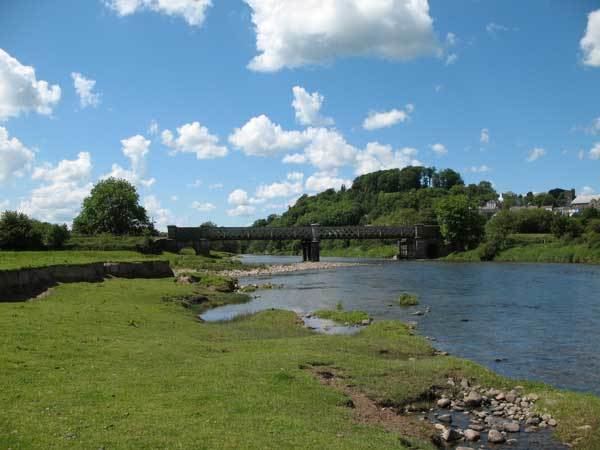- elevation 488 m (1,601 ft) Length 121 km Country United Kingdom | - average 45 m/s (1,589 cu ft/s) Basin area 515 km² | |
 | ||
Cities | ||
The River Towy or Tywi (Welsh: Afon Tywi) is one of the two longest rivers flowing entirely within Wales, (the other is the River Teifi) with a total length of 120 km (75 mi). It is noted for its sea trout and salmon fishing.
Contents
- Map of River Towy United Kingdom
- RouteEdit
- Damming of the TowyEdit
- Fish speciesEdit
- Animal lifeEdit
- Bird lifeEdit
- Plant lifeEdit
- Glanrhyd Bridge disasterEdit
- References
Map of River Towy, United Kingdom
RouteEdit
The river rises within 15 km (9.3 mi) of the Teifi on the lower slopes of Crug Gynan in the Cambrian Mountains and, flowing through the steep, rugged hills of the Towy Forest, forms the border between Ceredigion and Powys. The river flows generally south-westwards through Carmarthenshire passing through the towns of Llandovery and Llandeilo. In Carmarthen it is joined by a substantial tributary, the Afon Gwili, at Abergwili. Finally the Towy flows into Carmarthen Bay east of the Pendine Sands in an estuary which it shares with the River Taf and the two branches of the River Gwendraeth. The mouth of the Towy estuary is guarded by Llansteffan Castle, a 12th-century Norman castle.
The Towy's numerous tributaries include the Cothi, Gwili, Brân, and Doethie.
The Tywi's total length is 120 km (75 mi).
Damming of the TowyEdit
About 10 km (6.2 mi) from its source, the swift flow of the Towy is interrupted by the Llyn Brianne reservoir, created here in 1972 by damming a section of the river to store winter rain for release into the river during dry periods. The reservoir supports the new abstraction at Nantgaredig which supplies a large swathe of south-east Wales with drinking water. The flow in the River Towy would have been unable to sustain such an abstraction were it not for the release of water from the upland reservoir.
Fish speciesEdit
The Towy is a national draw for big sea trout (local name sewin), the seagoing form of the brown trout, Salmo trutta. These fish enter the river each spring and early summer to breed in the tributaries. The river is thought to produce more double-figure (10lb plus) sea trout than any other in Britain. Anglers and estuary netsmen have taken these fish to over 20 lb (9 kg) in weight. In summer and autumn there is also a substantial run of Atlantic salmon (Salmo salar). In May the Towy has a run of the rare and protected twaite shad (Alosa fallax) and allis shad (Alosa alosa). The Towy also contains brown trout, eels, pike, and a variety of small fish species, and is home to brook lampreys, river lampreys and sea lampreys. The Towy has the distinction of having accidentally produced by far the biggest fish ever taken on rod and line in fresh water in Britain. This was a sturgeon (Acipenser sturio) weighing 388 lb and nine feet two inches (2.75m) in length which was caught in the river near Nantgaredig by Alec Allen on July 28, 1932.
Animal lifeEdit
The Towy has a thriving population of otters (Lutra lutra), as well as many commoner mammal species. Grey seals are common in the lower reaches and sometimes penetrate several miles upriver in pursuit of sea trout and salmon.
Bird lifeEdit
The Towy and surrounding valley (Dyffryn Tywi) are home to a very large variety of water and wetland birds. Among the more distinctive species found along the river are sand martins, common sandpipers, little ringed plovers, dippers, kingfishers and grey wagtails. Red kites and buzzards are numerous. Goosanders and cormorants prey on sea trout and salmon.
Plant lifeEdit
The prevalence of oxbow lakes in the Towy valley provides some spectacular shows through the year. In summer at Bishop's Pond in Abergwili (actually a magnificent oxbow lake formed when the river flooded in 1802) there's a spectacular show of yellow water lilies on the pond when the water level drops and reed sweet-grass fringes the edges - a species also found nearby in the Teifi valley, further west in Pembrokeshire, on Gower, in Powys (especially along the Montgomery Canal), on Anglesey and in several other sites along the North Wales coast.
Glanrhyd Bridge disasterEdit
On 19 October 1987, three days after the Great Storm of 1987, four people were killed when a train plunged off Glanrhyd Bridge near Llangadog into the flooded river.
